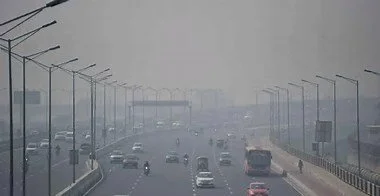Data Smog Engulfs Capital as Pollution Figures Vanish
As a thick grey haze shrouded the city on Monday, leaving Delhiites gasping for clean air, pollution data suddenly disappeared from official platforms for most of the day. From 1 p.m. onwards, the Central Pollution Control Board (CPCB) stopped releasing hourly Air Quality Index (AQI) updates as well as the city’s daily average, even as the smog visibly worsened through the afternoon.
Hourly AQI readings eventually reappeared on the CPCB website around 9 p.m., but data gaps remained across several monitoring stations. Neither the CPCB nor the Commission for Air Quality Management (CAQM) responded to TOI’s queries regarding the disruption.
An independent analysis showed that the average PM2.5 concentration between midnight and 9 p.m. on Monday stood at 249 micrograms per cubic metre—up from 215 µg/m³ the previous day—indicating “near severe” levels of pollution.
Until early afternoon, when the last set of reliable readings was posted, Delhi’s average PM2.5 levels matched Sunday’s numbers. Yet, the corresponding AQI was markedly higher, aligning with what residents could feel and see—the air thickening and visibility plummeting by evening.
By dusk, a biting stench filled the air, and flyovers and roads vanished into a yellow-grey blur. Commuters covered their faces and rushed indoors for relief.
“CPCB hasn’t updated any data since afternoon, and this isn’t the first time in the past two years,” said Sunil Dahiya, founder and lead analyst at Envirocatalysts. “When data disappears at such a critical time, it handicaps citizens, researchers, and regulators from responding effectively or taking preventive measures.”
Interestingly, while CPCB’s portal went dark after 1 p.m., the Delhi Pollution Control Committee (DPCC) site continued to show readings—suggesting that the monitors were operational and the glitch lay elsewhere. By 5:30 p.m., out of 562 monitoring stations across India, only four were showing live data.
While Delhi and Noida remained smothered in smog on Monday morning—with AQI readings of 345 and 318 respectively—Gurgaon appeared to fare much better at 221 (“poor”). But the air residents were breathing told a different story.
Since Diwali, Gurgaon’s average AQI has consistently appeared lower than that of other NCR cities, logging just two “very poor” days compared to Delhi’s prolonged streak of hazardous air. Experts say occasional variations are normal due to wind and microclimatic factors—but sustained discrepancies raise red flags.
A closer look at Gurgaon’s five continuous air monitoring stations—located at Vikas Sadan, Sector 51, TERI Gram, Gwalpahari, and Manesar—revealed that all are surrounded by dense vegetation or built structures, in violation of CPCB norms. According to regulations, monitors must be placed at least 20–30 metres from trees and 50 metres from major buildings, in open, well-ventilated areas.
These flawed placements—and irregular recordings of key pollutants like PM2.5 and sulphur dioxide (SO₂)—have skewed the city’s AQI downward. Data from CPCB’s portal shows Gwalpahari missed PM2.5 readings for hours on several days, while TERI Gram failed to capture SO₂ levels for extended periods. Because AQI averages are based on available readings, missing data can artificially improve the city’s pollution score.
“The stations are recording incomplete data, which makes AQI appear better than it should,” said Shubhansh Tiwari, research associate at the Centre for Science and Environment. “There are long gaps in PM2.5 data.”
LED display boards at all five sites have also been non-functional for weeks, further obscuring real-time information.
“The data is still being generated, but the LED screens have been shut for months,” confirmed Krishan Kumar, regional officer at the Haryana State Pollution Control Board (HSPCB).
Officials admit that growing vegetation within government and institutional premises has altered the air flow around these monitors. “The trees kept growing, but the monitors stayed where they were,” said one official. As a result, the stations now measure cleaner, trapped air—unlike the choking pollution most residents endure just outside.

